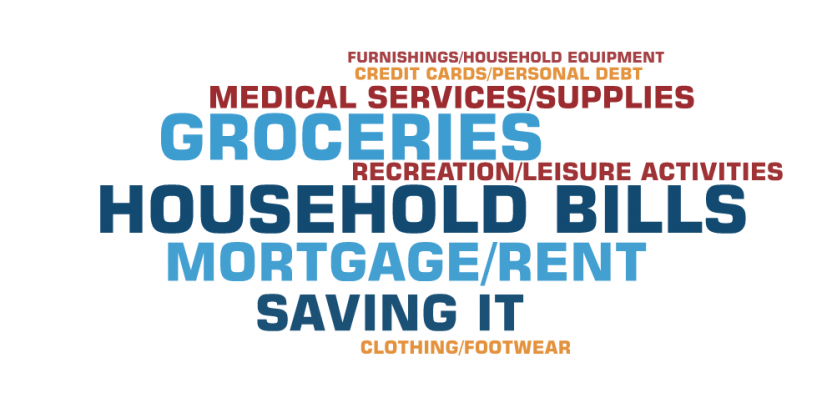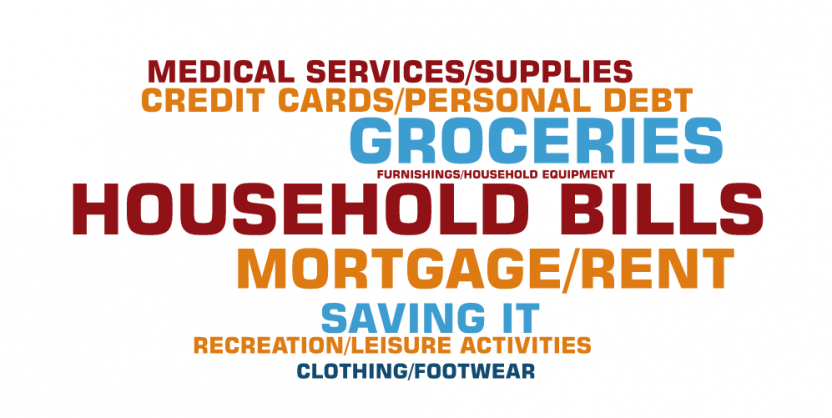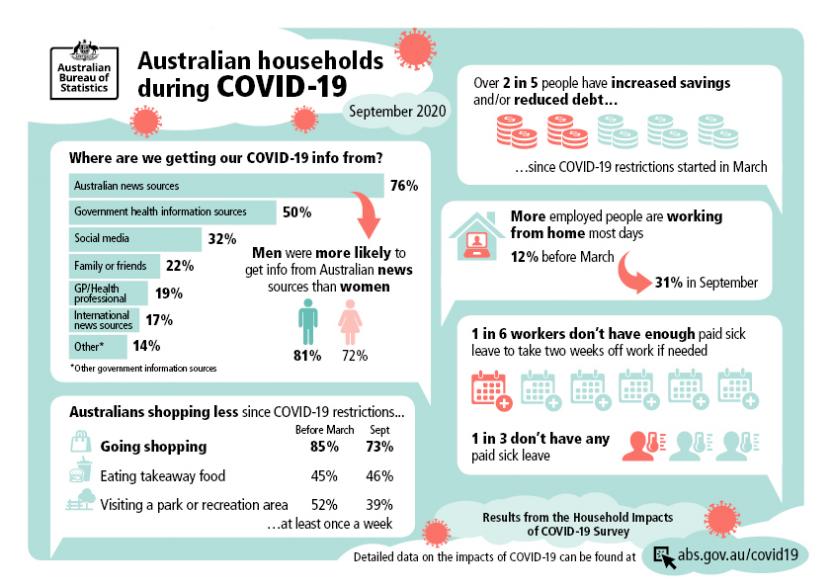About this issue
This publication presents results from the monthly Household Impacts of COVID-19 Survey, a longitudinal survey which collects information from around 1,500 people. The September 2020 survey was run between 11 September and 21 September 2020 via online forms and telephone interviews.
The September 2020 survey collected information on:
- changes in the frequency of activities
- health precautions taken due to COVID-19
- sources of health information and advice on COVID-19
- household finances and actions taken to relieve financial stress
- expected changes in spending patterns
- receipt and use of stimulus payments
- school and child care arrangements
- job status (including sick leave availability and search for employment).
The scope of the survey was persons aged 18 years and over in private dwellings across Australia (excluding very remote areas).
About this collection
This survey is designed to provide a quick snapshot of the changing social and economic situation for Australian households with particular focus on how they are faring in response to the COVID-19 pandemic. Each cycle will collect information on different topics.
From August 2020, the survey introduced a new panel of respondents but kept a similar design to the series of eight fortnightly surveys conducted between 1 April to 10 July 2020. In August 2020, there were an additional two detailed releases of results collected as part of the Multipurpose Household Survey (MPHS) during May and June 2020. The results for all past publications can be found by selecting 'View all releases' in the header of this publication.
Some topics have been repeated in both the fortnightly and monthly surveys. Where relevant, comparisons are made based on the weighted representative data for both surveys.
Due to the small sample size and associated high sample errors for this survey, it is not possible to meaningfully compare responses across all states and territories. Where possible, analysis has been conducted comparing estimates for New South Wales, Victoria and the rest of Australia.
Proportions marked with an asterisk (*) have a Margin of Error (MoE) >10 percentage points which should be considered when using this information. For more information about MoEs refer to the publication Methodology.
COVID-19 pandemic progress and interventions
From 11 September to 21 September, when this survey was conducted, around 30 new cases of COVID-19 were identified daily in Victoria and around six new cases daily in New South Wales. A number of cases in both Victoria and New South Wales were believed to be spread through community transmission (including known and unknown local contacts). Other states and territories were continuing to have lower numbers of COVID-19 cases (with no higher than three cases but often days with no new cases).
Since the beginning of the pandemic, initiatives in place to help reduce the spread of COVID-19 and support the economy included:
- ongoing international travel restrictions
- border control measures for some states and territories
- two economic stimulus packages (12 March and 22 March)
- a safety net package of $1.1 billion to expand mental health and Telehealth services, increase domestic violence services and provide more emergency food relief (29 March)
- stimulus payments including:
- a Coronavirus Supplement paid fortnightly from 27 April to eligible income support recipients along with their usual payments (to be reduced late September and paid until the end of December)
- a JobKeeper Payment passed in legislation on 15 April and paid to employers to keep more Australians in jobs and support businesses affected by the COVID-19 restrictions (extended until March 2021)
- various restrictions, including shutting down non-essential services, limits on gatherings and social distancing rules from March
- a guided easing of these restrictions in many states and territories using the National Cabinet agreed three step framework introduced in early May.
At the time of the survey, many states and territories were in the final stage of easing restrictions but progress had slowed in some areas due to the situation in Victoria. A second wave of COVID-19 emerged in Victoria from mid-June 2020 leading to stronger restrictions within the state from August, including:
- mandatory face coverings in public
- ‘stay at home’ restrictions including curfews and a small number of provisions to leave home for exercise, grocery shopping, and essential work, medical care and caregiving
- a return to remote learning for schools with onsite access to schools and child care restricted to essential workers with permits
- closing onsite operation of retail, administration and some manufacturing businesses for 6 weeks (with the exception of essential businesses)
- a Pandemic Leave Disaster Payment introduced for people who are required to take 14 days of leave to self-isolate or quarantine at home or care for someone with COVID-19 and who have no income or appropriate leave entitlements.
A roadmap for reopening restrictions in Victoria commenced from 13 September. The roadmap included steps to be implemented in metro Melbourne and regional Victoria in September through to November, depending on public health advice and progress in a number of areas including case and testing numbers.


